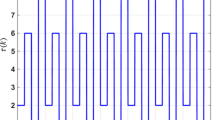Abstract
Methods to stabilize discrete-time linear control systems subject to variable sampling rates, i.e., using state feedback controllers, are well known in the literature. Several recent works address the use of the Tikhonov regularization method, originally designed to attenuate the noise effects on ill-posed problems, with the aim of improving performance and stabilizing approximately controllable dynamical systems. Inspired by these works, we propose the use of a feedback controller designed using the Tikhonov method to regularize discrete-time linear systems subject to varying sampling rates. The goal is to minimize an error function, thus improving the performance of the closed loop system and reducing the possibility of instability. Illustrative examples show the effectiveness of the proposed method.
Similar content being viewed by others
Explore related subjects
Discover the latest articles, news and stories from top researchers in related subjects.References
B. Wittenmark, J. Nilsson, M. Törngren. Timing problems in real-time control systems. In Proceedings of American Control Conference, IEEE, Seattle, USA, pp. 2000–2004, 1995. DOI: https://doi.org/10.1109/ACC.1995.531240.
A. Rabello, A. Bhaya. Stability of asynchronous dynamical systems with rate constraints and applications. IEE Proceedings-Control Theory and Applications, vol. 150, no. 5, pp. 546–550, 2003. DOI: https://doi.org/10.1049/ip-cta:20030704.
A. Bhaya, P. R. Medeiros. On the stability of asynchronous multirate linear systems. In Proceedings of the 36th IEEE Conference on Decision and Control, IEEE, San Diego, USA, pp. 2041–2042, 1997. DOI: https://doi.org/10.1109/CDC.1997.657066.
V. S. Ritchey, G. F. Franklin. A stability criterion for asynchronous multirate linear systems. IEEE Transactions on Automatic Control, vol.34, no.5, pp.529–535, 1989. DOI: https://doi.org/10.1109/9.24205.
L. Hetel, J. Daafouz, C. Iung. Analysis and control of LTI and switched systems in digital loops via an event-based modelling. International Journal of Control, vol.81, no.7, pp. 1125–1138, 2008. DOI: https://doi.org/10.1080/00207170701670442.
R. Shorten, F. Wirth, O. Mason, K. Wulff, C. King. Stability criteria for switched and hybrid systems. SIAM Review, vol.49, no.4, pp.545–592, 2007. DOI: https://doi.org/10.1137/05063516X.
V. D. Blondel, Y. Nesterov, J. Theys, Approximations of the rate of growth of switched linear systems. In Proceedings of the 7th International Workshop on Hybrid Systems: Computation and Control, Springer, Philadelphia, USA, vol.2993, pp. 173–186, 2004. DOI: https://doi.org/10.1007/978-3-540-24743-212.
M. Schinkel, W. H. Chen, A. Rantzer. Optimal control for systems with varying sampling rate. In Proceedings of American Control Conference, IEEE, Anchorage, USA, pp. 2979–2984, 2002. DOI: https://doi.org/10.1109/ACC.2002.1025245.
F. E. Felicioni, S. J. Junco. A Lie algebraic approach to design of stable feedback control systems with varying sampling rate. In Proceedings of the 17th World Congress of the International Federation of Automatic Control, IFAC, Seoul, South Korea, pp. 4881–4886, 2008.
M. Schinkel, W. H. Chen. Control of sampled-data systems with variable sampling rate. International Journal of Systems Science, vol.37, no.9, pp.609–618, 2006. DOI: https://doi.org/10.1080/00207720600681161.
F. Felicioni. Stabilitéet Performance des Systèmes Distribués de Contrôle-Commande, Ph.D. dissertation, Nancy University, Lorraine, France, 2011. (in Spanish)
A. Sala. Computer control under time-varying sampling period: An LMI gridding approach. Automatica, vol.41, no. 12, pp.2077–2082, 2005. DOI: https://doi.org/10.1016/j.automatica.2005.05.017.
F. Pazos, A. Zanini, A. Bhaya. Stabilization of discrete-time linear systems with varying sampling rates via a state feedback controller. In Proceedings of the 14th Brazilian Conference on Dynamics, Control and Applications, Säo Carlos, Brazil, 2019. (to be published)
D. Liberzon, R. Tempo. Common Lyapunov functions and gradient algorithms. IEEE Transactions on Automatic Control, vol.49, no.6, pp.990–994, 2004. DOI: https://doi.org/10.1109/TAC.2004.829632.
B. Tang, Q. J. Zeng, D. F. He, Y. Zhang. Random stabilization of sampled-data control systems with nonuniform sampling. International Journal of Automation and Computing, vol.9, no.5, pp.492–500, 2012. DOI: https://doi.org/10.1007/s11633-012-0672-y.
C. C. Hua, S. C. Yu, X. P. Guan. Finite-time control for a class of networked control systems with short time-varying delays and sampling jitter. International Journal of Automation and Computing, vol.12, no. 4, pp. 448–454, 2015. DOI: https://doi.org/10.1007/s11633-014-0849-7.
C. C. Sun. Stabilization for a class of discrete-time switched large-scale systems with parameter uncertainties. International Journal of Automation and Computing, vol.16, no.4, pp.543–552, 2019. DOI: https://doi.org/10.1007/s11633-016-0966-6.
L. G. Wu, Y. B. Gao, J. X. Liu, H. Y. Li. Event-triggered sliding mode control of stochastic systems via output feedback. Automatica, vol.82, pp.79–92, 2017. DOI: https://doi.org/10.1016/j.automatica.2017.04.032.
J. X. Liu, L. G. Wu, C. W. Wu, W. S. Luo, L. G. Fran-quelo. Event-triggering dissipative control of switched stochastic systems via sliding mode. Automatica, vol. 103, pp. 261–273, 2019. DOI: https://doi.org/10.1016/j.automatica.2019.01.029.
M. T. Nair, N. Sukavanam, R. Katta. Computation of control for linear approximately controllable system using Tikhonov regularization. Numerical Functional Analysis and Optimization, vol.39, no.3, pp.308–321, 2018. DOI: https://doi.org/10.1080/01630563.2017.1361440.
R. Katta, G. D. Reddy, N. Sukavanam. Computation of control for linear approximately controllable system using weighted Tikhonov regularization. Applied Mathematics and Computation, vol.317, pp. 252–263, 2018. DOI: https://doi.org/10.1016/j.amc.2017.08.012.
R. Katta, N. Sukavanam. Computation of control for nonlinear approximately controllable system using Tikhonov regularization. Cogent Mathematics, vol.3, no. 1, Article number 1216241, 2016 DOI: https://doi.org/10.1080/23311835.2016.1216241.
M. Loaiza. A short introduction to Hilbert space theory. Journal of Physics: Conference Series, vol.839, no. 1, Article number 012002, 2017. DOI: https://doi.org/10.1088/1742-6596/839/1/012002.
M. T. Nair. On controllability of linear systems, Department of Mathematics, HT Madras, Madras, India, Technical Report, [Online], Available: https://math.iitm.ac.in/public_html/mtnair/IIST-control-mtn.pdf, November 28–29, 2012.
R. F. Curtain, H. Zwart, An Introduction to Infinite-dimensional Linear Systems Theory, New York, USA: Springer-Verlag, 1995. DOI: https://doi.org/10.1007/978-1-4612-4224-6.
C. T. Chen. Linear System Theory and Design, 3rd ed., New York, USA: Oxford University Press, 1999.
H. W. Engl, M. Hanke, A. Neubauer, Regularization of Inverse Problems, London, UK: Kluwer Academic Publishers, 1996.
A. N. Tikhonov, V. Y. Arsenin, Solutions of Ill-Posed Problems, Washington, USA: Winston and Sons, 1977.
V. A. Morozov, Regularization Methods for Ill-Posed Problems, Boca Raton, USA: CRC Press, 1993.
G. H. Golub, M. Heath, G. Wahba. Generalized cross-validation as a method for choosing a good ridge parameter. Technometrics, vol.21, no.2, pp.215–223, 1979. DOI: https://doi.org/10.1080/00401706.1979.10489751.
P. C. Hansen. The L-curve and its use in the numerical treatment of inverse problems. Computational Inverse Problems in Electrocardiology, P. Johnston, Ed., Southampton, UK: IMM, 2001.
P. C. Hansen, D. P. O’Leary. The use of the L-curve in the regularization of discrete ill-posed problems.. SIAM Journal on Scientific Computing, vol.14, no. 6, pp. 1487–1503, 1993. DOI: https://doi.org/10.1137/0914086.
F. Pazos, A. Bhaya. Adaptive choice of the Tikhonov regularization parameter to solve ill-posed linear algebraic equations via Liapunov optimizing control. Journal of Computational and Applied Mathematics, vol.279, pp. 123–132, 2015. DOI: https://doi.org/10.1016/j.cam.2014.10.022.
F. Bauer, M. A. Lukas. Comparingparameter choice methods for regularization of ill-posed problems. Mathematics and Computers in Simulation, vol.81, no. 9, pp. 1795–1841, 2011. DOI: https://doi.org/10.1016/j.matcom.2011.01.016.
K. Kunisch, J. Zou. Iterative choices of regularization parameters in linear inverse problems. Inverse Problems, vol.14, no. 5, pp. 1247–1264, 1998. DOI: https://doi.org/10.1088/0266-5611/14/5/010.
H. Gfrerer. An a posteriori parameter choice for ordinary and iterated Tikhonov regularization of ill-posed problems leading to optimal convergence rates. Mathematics of Computation, vol.49, no. 180, pp.507–522, 1987. DOI: https://doi.org/10.2307/2008325.
L. Reichel, G. Rodriguez. Old and new parameter choice rules for discrete ill-posed problems. Numerical Algorithms, vol.63, no. 1, pp.65–87, 2013. DOI: https://doi.org/10.1007/s11075-012-9612-8.
T. Reginska. A regularization parameter in discrete ill-posed problems. SIAM Journal on Scientific Computing, vol.17, no. 3, pp. 740–749, 1996. DOI: https://doi.org/10.1137/S1064827593252672.
D. Zhang, T. Z. Huang. Generalized Tikhonov regularization method for large-scale linear inverse problems. Journal of Computational Analysis and Applications, vol. 15, no. 7, pp. 1317–1331, 2013.
K. J. Åström, B. Wittenmark, Computer Controlled Systems: Theory and Design, Englewood Cliffs, USA: Prentice-Hall, 1984.
G. F. Franklin, J. D. Powell, M. L. Workman, Digital Control of Dynamic Systems, 3rd ed., Menlo Park, USA: Ad-dison-Wesley, 1997.
P. C. Hansen. Regularization tools version 4.0 for Matlab 7.3. Numerical Algorithms, vol.46, no.2, pp. 189–194, 2007. DOI: https://doi.org/10.1007/s11075-007-9136-9.
Acknowledgments
The authors would like to thank the editor and the anonymous reviewers for their valuable comments and helpful suggestions that have contributed to the improvement of the paper.
Author information
Authors and Affiliations
Corresponding author
Additional information
Fernando Agustín Pazos received the B. Sc. degree in electronic engineering from the University of Buenos Aires, Argentina in 1990, the M.Sc. and D.Sc. degrees in electrical engineering from the Federal University of Rio de Janeiro, Brazil in 2000 and 2007, respectively. He is a professor in the Electronic and Telecommunications Engineering Department, the State University of Rio de Janeiro, Brazil. He is an author of “Automação de Sistemas & Robótica” (Axcel Books, Rio de Janeiro, Brazil 2002).
His research interest is development of algorithms to solve several optimization problems interpreting them as closed loop control systems.
Anibal Zanini received the B.Eng. degree in electrical engineering from Universidad Nacional de Rosario, Argentina in 1977, and recived the Ph. D. degree in electrical engineering at the Escuela Técnica Superior de Ingenieros Industriales of the Universidad Politécnica de Madri, Spain in 1983. He has worked for 20 years as project leader and senior researcher in the automation area at metallurgical industry. Since 1998, his main activity is at Universidad de Buenos Aires. He is a professor at the Engineering School of “Universidad de Buenos Aires”.
His research interests include industrial control, identification and adaptive control.
Amit Bhaya received the B.Eng. degree in eletrical engineering from the Indian Institute of Technology, India in 1981, and received the Ph.D. degree in eletrical engineering from the University of California at Berkeley, USA in 1986. He is a professor in the Electrical Engineering Department, Graduate School of Engineering, the Federal University of Rio de Janeiro (COPPE/UFRJ), Brazil. He coauthored the books “Matrix Diagonal Stability in Systems and Computation” (Birkhäuser, 2000), and “Control Perspectives on Numerical Algorithms and Matrix Problems” (SIAM, 2006). He was an associate editor of the IEEE Transactions on Neural Networks and Learning Systems from 2010 to 2012.
His research interests include systems and control theory, parallel computation, neural networks, matrix stability theory, mathematical ecology and optimization of economic dynamic systems.
Rights and permissions
About this article
Cite this article
Pazos, F.A., Zanini, A. & Bhaya, A. Performance Improvement of Discrete-time Linear Control Systems Subject to Varying Sampling Rates Using the Tikhonov Regularization Method. Int. J. Autom. Comput. 17, 453–463 (2020). https://doi.org/10.1007/s11633-019-1205-8
Received:
Accepted:
Published:
Issue Date:
DOI: https://doi.org/10.1007/s11633-019-1205-8




